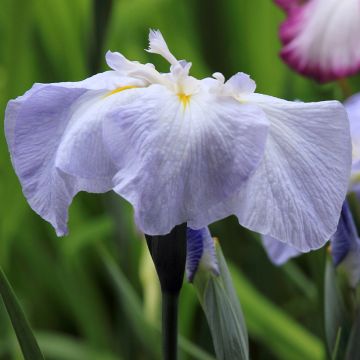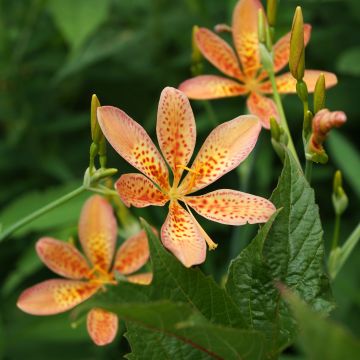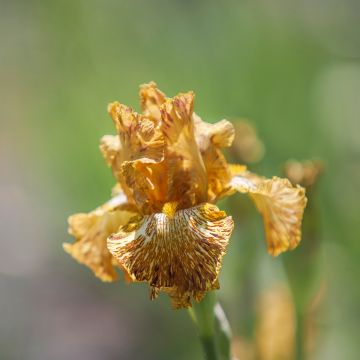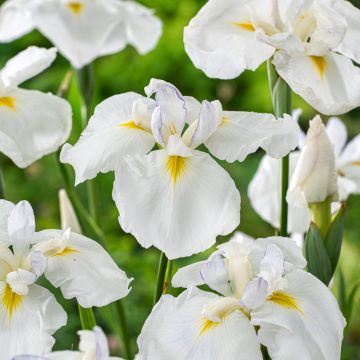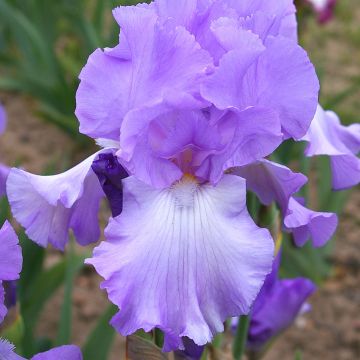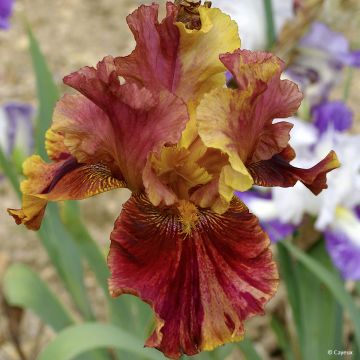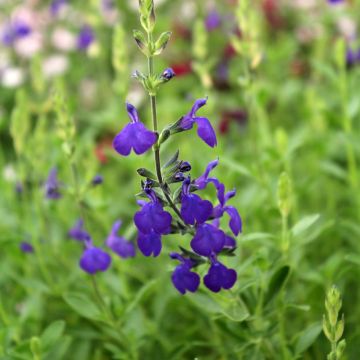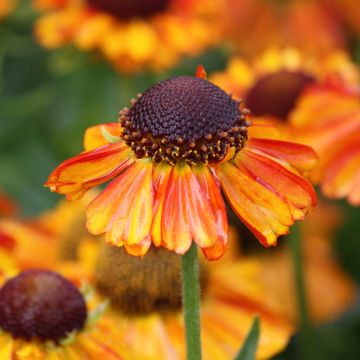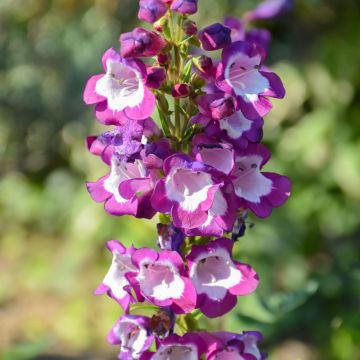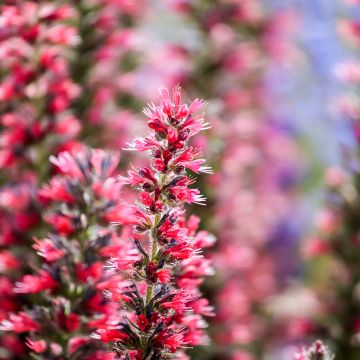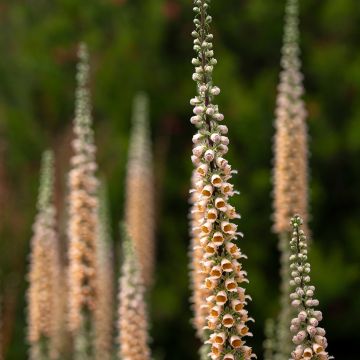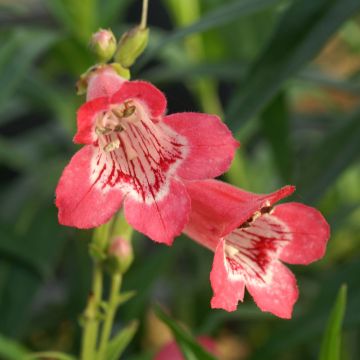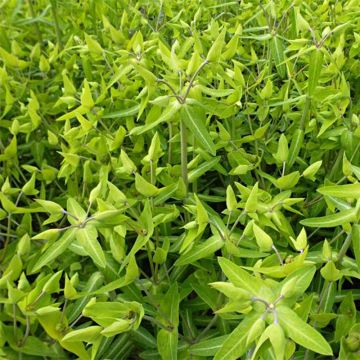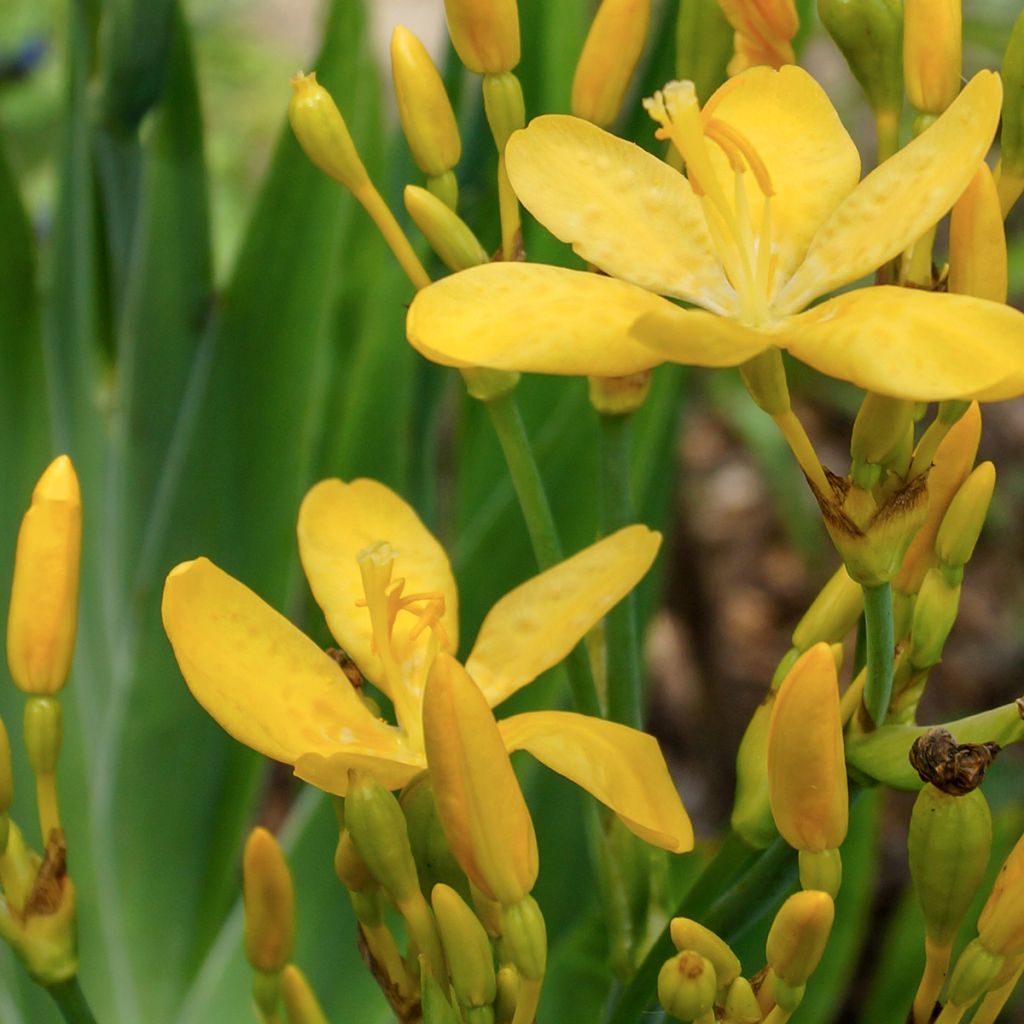

Belamcanda chinensis Hello Yellow
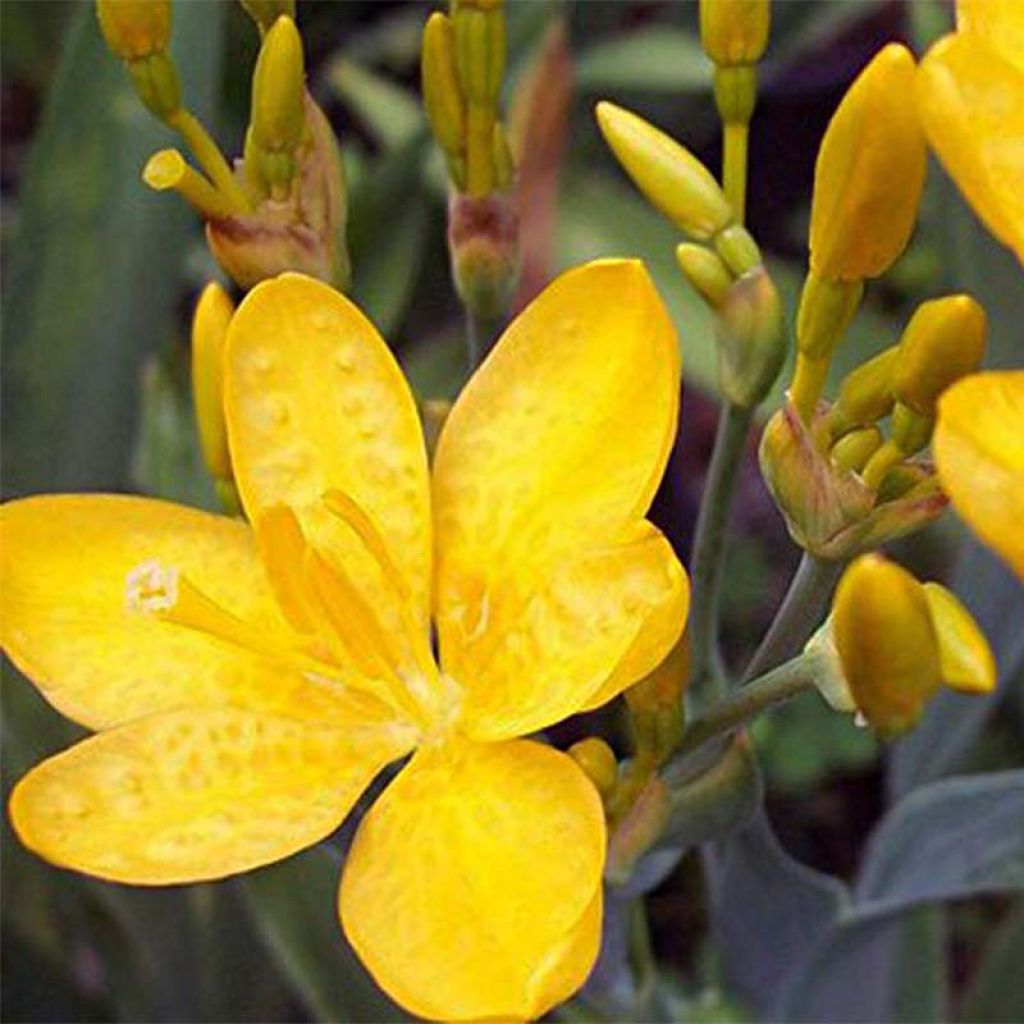

Belamcanda chinensis Hello Yellow
Belamcanda chinensis Hello Yellow
Belamcanda chinensis Hello Yellow
Blackberry Lily, Leopard Lily
Special offer!
Receive a €20 voucher for any order over €90 (excluding delivery costs, credit notes, and plastic-free options)!
1- Add your favorite plants to your cart.
2- Once you have reached €90, confirm your order (you can even choose the delivery date!).
3- As soon as your order is shipped, you will receive an email containing your voucher code, valid for 3 months (90 days).
Your voucher is unique and can only be used once, for any order with a minimum value of €20, excluding delivery costs.
Can be combined with other current offers, non-divisible and non-refundable.
Home or relay delivery (depending on size and destination)
Schedule delivery date,
and select date in basket
This plant carries a 12 months recovery warranty
More information
We guarantee the quality of our plants for a full growing cycle, and will replace at our expense any plant that fails to recover under normal climatic and planting conditions.
Would this plant suit my garden?
Set up your Plantfit profile →
Description
Belamcanda chinensis 'Hello Yellow' is a lovely variety of Tiger Lily with pure yellow flowers, without tiger or speckled patterns, unlike the typical species often nicknamed 'Leopard Flower' due to its spotted and dotted flowers. It is an elegant rhizomatous perennial plant related to our garden Iris, but of Asian origin. It forms a clump of narrow, upright fan-shaped leaves from which branched flower stems emerge in summer, as elegant as they are bright. Easy to grow in full sun in any well-drained soil, even poor soil, this plant deserves a place in natural areas of the garden where it will self-seed.
The Tiger Lily belongs to the family Iridaceae. As the only species in the Belamcanda genus, this plant has recently been moved, following DNA analysis, into the Iris genus. It is currently known as Iris domestica. It is native to high altitude areas of Southeast Asia, India, and Japan. The plant has an upright clumping habit that quickly reaches a height of 60cm (24in) when flowering, 40cm (16in) for the foliage, and a spread of 30cm (12in). The flowering occurs from June to August, depending on the climate. The flower stems are terminated by 3 to 12 umbels of star-shaped yellow flowers, with corollas composed of 6 petals, 5cm (2in) in diameter; they are followed by shiny black fruits, very decorative, exposed on open capsules. The fruits, if allowed to mature, will enable the plant to self-seed and replace plants that have been cut down by a harsh winter. This Tiger Lily produces large basal leaves in spring, similar to Iris leaves, glaucous green in colour, with fine texture and prominent veins. It propagates through rhizomes.
Belamcanda chinensis 'Hello Yellow' is no more difficult to grow than German Iris, but it requires well-drained soil. In heavy, moisture-laden soil during winter, it disappears. It is a frugal plant that can be planted in light, even poor, well-drained, and moist to dry soil. In nature, it is found in slightly sandy areas. Use it in rock gardens, borders, on slopes, anywhere Irises thrive, as they take over. The sunny colour of its corollas will beautifully complement the blue flowers of perennial flax, wild chicory, small scabious, and the delicate beauty of Damask Nigella in a very natural scene. Offer them a backdrop of grey cushions, such as those of Artemisia stelleriana 'Boughton Silver' or Artemisia alba 'Canescens'. The pods open widely to reveal shiny black seeds often used in dried bouquets.
Iris domestica is used in traditional Chinese medicine, as its rhizome contains several medically active molecules.
Report an error about the product description
Belamcanda chinensis Hello Yellow in pictures
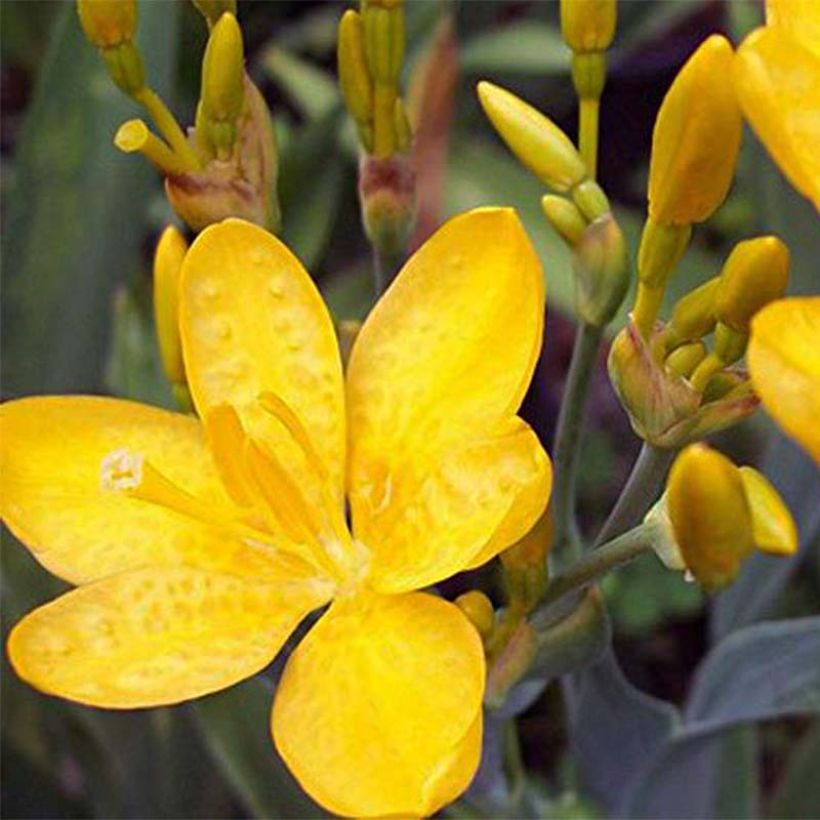

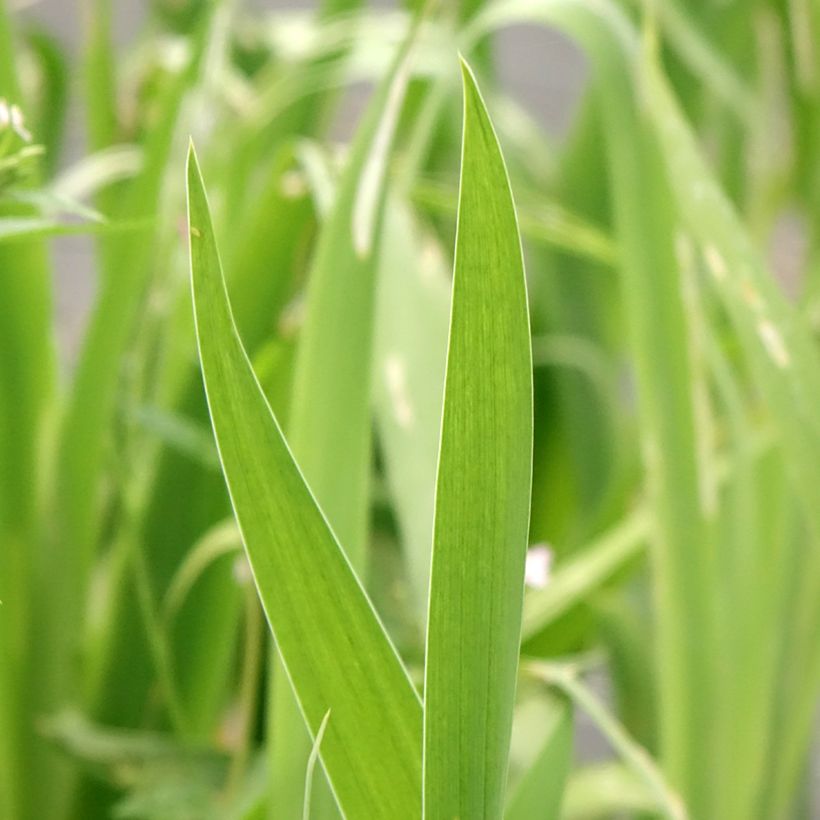

Flowering
Foliage
Plant habit
Botanical data
Belamcanda
chinensis
Hello Yellow
Iridaceae
Blackberry Lily, Leopard Lily
Southeast Asia
Other Iris
View all →Planting and care
Belamcanda chinensis is no more difficult to grow than Iris germanica, but it requires well-drained soil. In heavy, moisture-soaked soil during winter, it disappears. It is an undemanding young plant that should be planted in light, even poor, well-draining soil that is occasionally dry. In nature, it is found in slightly sandy soils. It is best planted in spring or autumn in mild climates, at a depth of 5cm (2in) and with a spacing of 15-25cm (6-10in), in full sun or partial shade. The stump can be protected before winter in regions with a hardiness limit of -10 to -15°C (14 to 5°F). Remove faded flowers from a few plants to prevent exhaustion. Allowing the fruits to mature will enable the plant to self-seed and replace plants that were cut down by a harsh winter.
Planting period
Intended location
Care
This item has not been reviewed yet - be the first to leave a review about it.
Similar products
Haven't found what you were looking for?
Hardiness is the lowest winter temperature a plant can endure without suffering serious damage or even dying. However, hardiness is affected by location (a sheltered area, such as a patio), protection (winter cover) and soil type (hardiness is improved by well-drained soil).

Photo Sharing Terms & Conditions
In order to encourage gardeners to interact and share their experiences, Promesse de fleurs offers various media enabling content to be uploaded onto its Site - in particular via the ‘Photo sharing’ module.
The User agrees to refrain from:
- Posting any content that is illegal, prejudicial, insulting, racist, inciteful to hatred, revisionist, contrary to public decency, that infringes on privacy or on the privacy rights of third parties, in particular the publicity rights of persons and goods, intellectual property rights, or the right to privacy.
- Submitting content on behalf of a third party;
- Impersonate the identity of a third party and/or publish any personal information about a third party;
In general, the User undertakes to refrain from any unethical behaviour.
All Content (in particular text, comments, files, images, photos, videos, creative works, etc.), which may be subject to property or intellectual property rights, image or other private rights, shall remain the property of the User, subject to the limited rights granted by the terms of the licence granted by Promesse de fleurs as stated below. Users are at liberty to publish or not to publish such Content on the Site, notably via the ‘Photo Sharing’ facility, and accept that this Content shall be made public and freely accessible, notably on the Internet.
Users further acknowledge, undertake to have ,and guarantee that they hold all necessary rights and permissions to publish such material on the Site, in particular with regard to the legislation in force pertaining to any privacy, property, intellectual property, image, or contractual rights, or rights of any other nature. By publishing such Content on the Site, Users acknowledge accepting full liability as publishers of the Content within the meaning of the law, and grant Promesse de fleurs, free of charge, an inclusive, worldwide licence for the said Content for the entire duration of its publication, including all reproduction, representation, up/downloading, displaying, performing, transmission, and storage rights.
Users also grant permission for their name to be linked to the Content and accept that this link may not always be made available.
By engaging in posting material, Users consent to their Content becoming automatically accessible on the Internet, in particular on other sites and/or blogs and/or web pages of the Promesse de fleurs site, including in particular social pages and the Promesse de fleurs catalogue.
Users may secure the removal of entrusted content free of charge by issuing a simple request via our contact form.
The flowering period indicated on our website applies to countries and regions located in USDA zone 8 (France, the United Kingdom, Ireland, the Netherlands, etc.)
It will vary according to where you live:
- In zones 9 to 10 (Italy, Spain, Greece, etc.), flowering will occur about 2 to 4 weeks earlier.
- In zones 6 to 7 (Germany, Poland, Slovenia, and lower mountainous regions), flowering will be delayed by 2 to 3 weeks.
- In zone 5 (Central Europe, Scandinavia), blooming will be delayed by 3 to 5 weeks.
In temperate climates, pruning of spring-flowering shrubs (forsythia, spireas, etc.) should be done just after flowering.
Pruning of summer-flowering shrubs (Indian Lilac, Perovskia, etc.) can be done in winter or spring.
In cold regions as well as with frost-sensitive plants, avoid pruning too early when severe frosts may still occur.
The planting period indicated on our website applies to countries and regions located in USDA zone 8 (France, United Kingdom, Ireland, Netherlands).
It will vary according to where you live:
- In Mediterranean zones (Marseille, Madrid, Milan, etc.), autumn and winter are the best planting periods.
- In continental zones (Strasbourg, Munich, Vienna, etc.), delay planting by 2 to 3 weeks in spring and bring it forward by 2 to 4 weeks in autumn.
- In mountainous regions (the Alps, Pyrenees, Carpathians, etc.), it is best to plant in late spring (May-June) or late summer (August-September).
The harvesting period indicated on our website applies to countries and regions in USDA zone 8 (France, England, Ireland, the Netherlands).
In colder areas (Scandinavia, Poland, Austria...) fruit and vegetable harvests are likely to be delayed by 3-4 weeks.
In warmer areas (Italy, Spain, Greece, etc.), harvesting will probably take place earlier, depending on weather conditions.
The sowing periods indicated on our website apply to countries and regions within USDA Zone 8 (France, UK, Ireland, Netherlands).
In colder areas (Scandinavia, Poland, Austria...), delay any outdoor sowing by 3-4 weeks, or sow under glass.
In warmer climes (Italy, Spain, Greece, etc.), bring outdoor sowing forward by a few weeks.






























